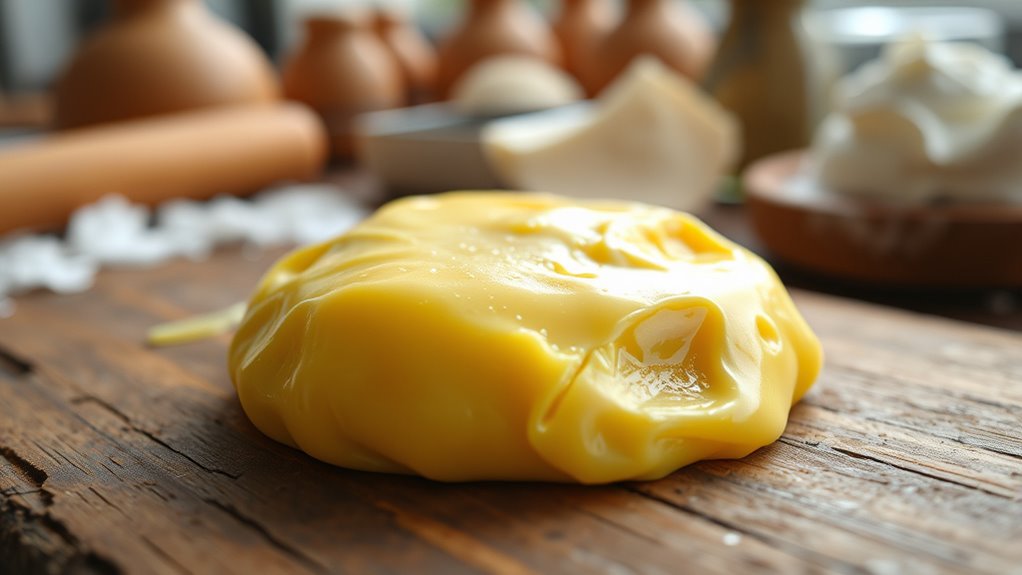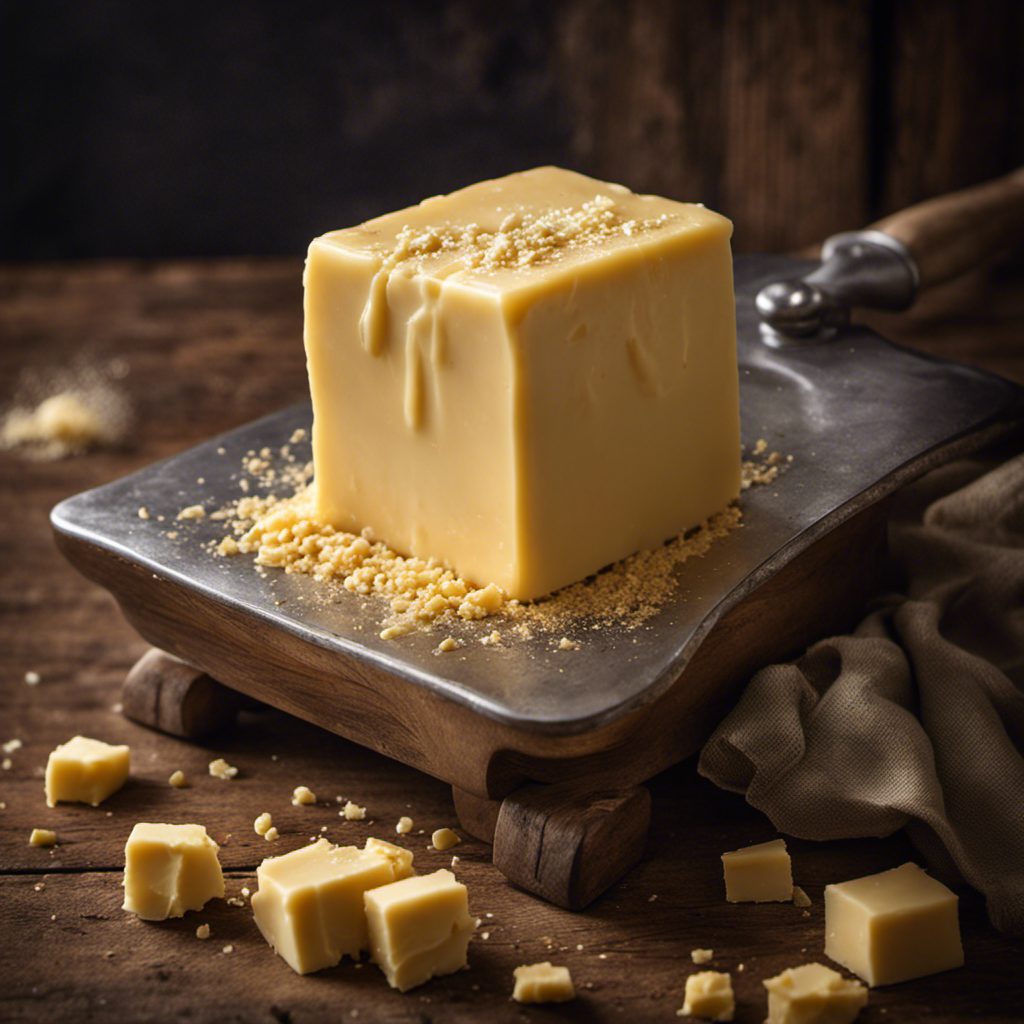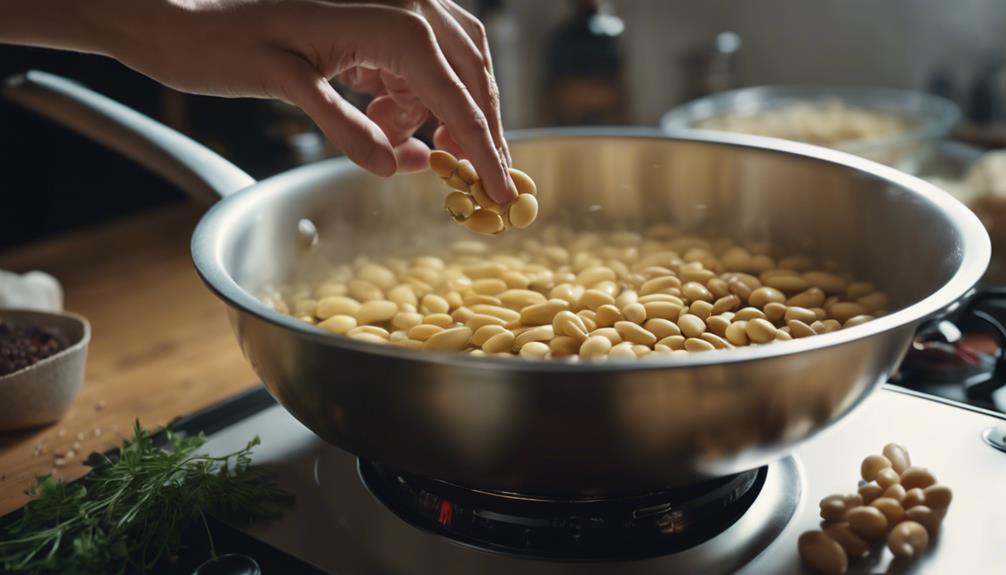The pH of butter typically ranges between 6.1 and 6.4 and impacts much more than just baking. A lower pH can add tangy flavors and help preserve freshness, while a higher pH makes butter softer and more spreadable. Monitoring pH helps maintain quality, control spoilage, and extend shelf life. Understanding how pH influences these factors allows you to improve production, storage, and even final product consistency—if you continue exploring, you’ll see how pH plays a essential role in butter quality.
Key Takeaways
- pH influences butter’s flavor, texture, and stability, impacting quality beyond just baking applications.
- Monitoring pH helps prevent spoilage and extends shelf life by controlling microbial growth.
- Proper pH levels ensure consistent fermentation, affecting butter’s firmness and spreadability.
- pH adjustments during production can optimize flavor development and preserve freshness.
- Understanding pH is essential for maintaining dairy product safety and achieving desired sensory qualities.
What Is the Ph Range of Butter?
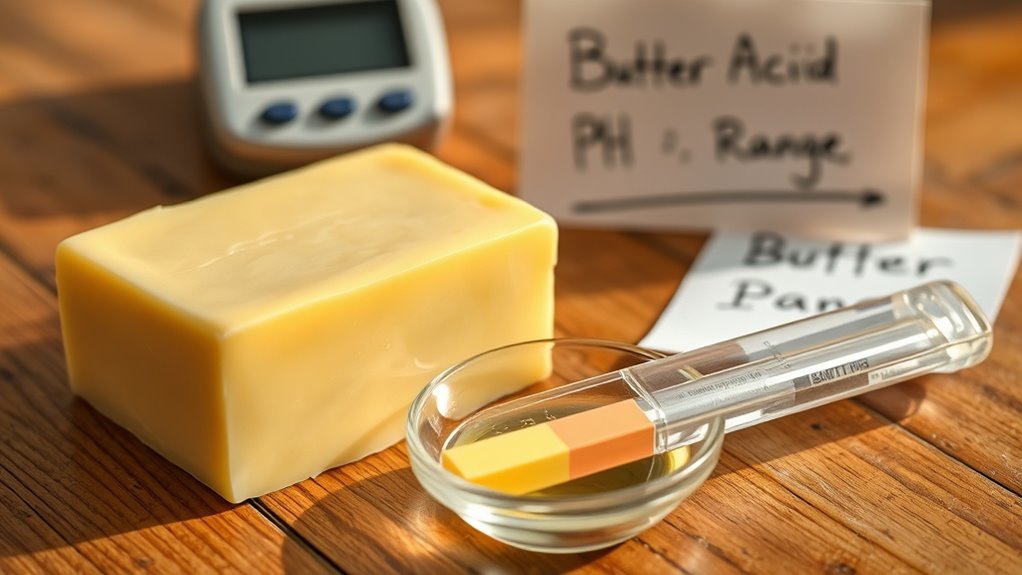
What is the pH range of butter? Typically, butter has a pH between 6.1 and 6.4, making it slightly acidic but still close to neutral. During butter fermentation, bacterial cultures can influence dairy acidity, slightly lowering the pH and affecting flavor and texture. This fermentation process involves bacteria converting residual milk sugars into lactic acid, which increases dairy acidity and can make the butter more tangy. Understanding this pH range helps you gauge butter’s freshness and quality, as significant deviations may indicate spoilage or improper handling. The natural pH of butter reflects its production process and the fermentation stage of the dairy, which directly impacts its flavor profile and shelf life. Additionally, home storage practices can influence butter’s pH over time, emphasizing the importance of proper handling.
How Ph Influences Butter’S Flavor Profile

The pH level of butter directly shapes its flavor profile by influencing the development of certain compounds during production and storage. During dairy fermentation, microbial activity can alter pH, affecting the formation of flavor-enhancing compounds. A slightly lower pH encourages the development of tangy, complex flavors, while a higher pH can result in a milder, creamier taste. Controlling pH helps preserve freshness and prevents off-flavors caused by spoilage. As butter ages, subtle shifts in pH can intensify or mellow specific flavor notes, making it more or less desirable. Understanding how pH influences dairy fermentation processes allows you to optimize flavor enhancement, ensuring your butter maintains its desired taste profile throughout its shelf life. Additionally, monitoring and adjusting pH levels can influence the fermentation process, ultimately elevating the quality and consistency of your product.
The Role of Ph in Butter’S Texture and Consistency

Your butter’s pH level influences its fat structure, affecting how firm or soft it feels. It also impacts spreadability, making it easier or harder to spread smoothly. Additionally, pH can alter the butter’s flavor, connecting texture and taste in ways you might not expect. Using unique and wicked planters in your kitchen can also help you grow fresh herbs, enhancing flavor and freshness in your butter.
Ph and Fat Structure
Since pH influences the structure of fats in butter, it directly affects its texture and consistency. During butter fermentation, dairy acidity changes the pH, impacting fat molecules’ arrangement. A lower pH from fermentation causes fats to become more stable, resulting in a firmer texture. Conversely, higher pH levels can weaken fat bonds, making butter softer and more spreadable. The acidity affects how fats interact with water and proteins, altering the overall consistency. Additionally, the calibration of pH levels during processing can help ensure consistent butter quality. Understanding this relationship helps you control butter’s firmness and mouthfeel. By managing dairy acidity during processing, you can fine-tune the fat structure to achieve your desired texture. Ultimately, pH isn’t just about taste; it plays an essential role in the physical properties of butter.
Ph Impact on Spreadability
pH levels directly influence butter’s spreadability by affecting its internal fat structure. When pH is properly balanced through butter fermentation, the fat crystals form a more uniform network, making the butter easier to spread straight from the fridge. If the pH drops too low, the butter becomes more solid and less pliable. Conversely, higher pH levels can lead to a softer, more spreadable texture. Maintaining the right pH during butter fermentation ensures perfect texture and spreadability, making your butter suitable for any use. Additionally, proper fermentation helps preserve the butter’s flavor and quality over time.
Ph and Flavor Profile
How pH influences butter’s flavor profile is a key aspect of its overall quality. During butter fermentation, the dairy acidity shifts, affecting the pH level. A lower pH from fermentation produces a tangier, more complex flavor, while higher pH results in a milder taste. The pH level also impacts the balance of buttery notes and can introduce subtle sour or nutty flavors. When the dairy acidity is carefully controlled, it enhances the butter’s aroma and depth, making it more appealing. If the pH is too high or too low, it can lead to off-flavors or undesirable tastes. Understanding how pH interacts with butter fermentation helps producers craft a product with a consistent and desirable flavor profile. Additionally, fluctuations in pH can sometimes cause unforeseen failures in production, emphasizing the importance of precise pH management.
Ph and the Shelf Life of Butter
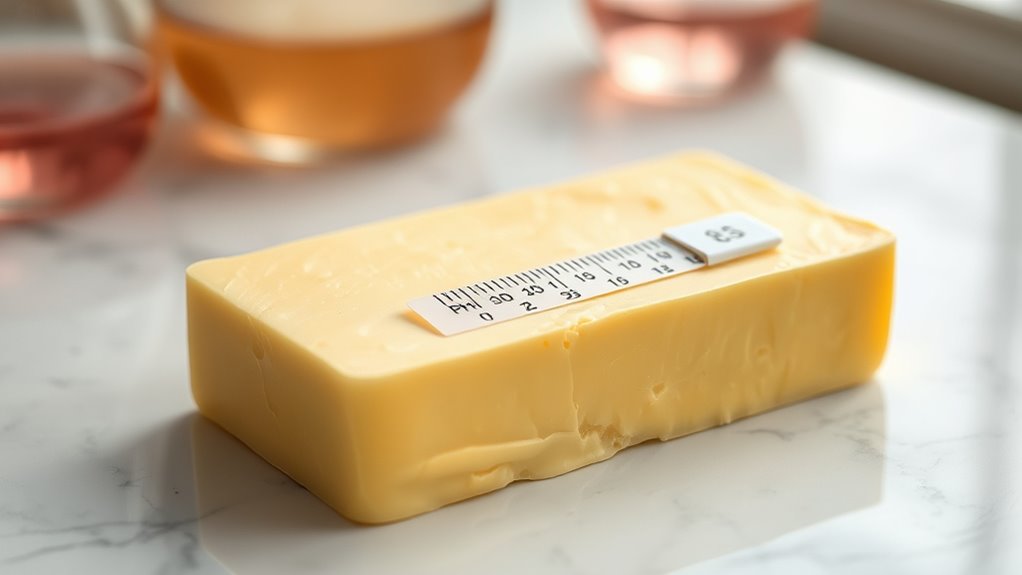
Your butter’s pH level directly influences how long it stays fresh by affecting bacterial growth and spoilage. A more acidic pH slows down bacteria, extending shelf life, while a higher pH can speed up spoilage. Understanding this balance helps you choose and store butter to keep it fresh longer. Additionally, the quality of ingredients used in making butter can also impact its pH and overall shelf life.
Acidic Ph and Spoilage
Ever wonder how the acidity level of butter influences its freshness? The pH plays a critical role in preventing spoilage. When the acidity is well-controlled through dairy fermentation, it creates an environment less hospitable to harmful bacteria, extending shelf life. Conversely, higher pH levels can accelerate spoilage. Here’s how acidity impacts butter longevity:
- Inhibits spoilage bacteria growth by creating an unfavorable environment.
- Maintains quality through proper acidity control during production.
- Prevents off-flavors caused by microbial activity.
Ph Impact on Bacteria
The pH level directly influences bacterial growth in butter, which in turn affects its shelf life. If the pH is too high, it creates an environment favorable for harmful microbes, accelerating spoilage. During dairy fermentation, beneficial bacteria lower the pH, inhibiting pathogenic microbial growth and prolonging freshness. Conversely, a higher pH encourages microbial activity, risking faster deterioration. Maintaining an ideal pH helps control microbial growth, ensuring butter stays safe longer. Understanding how pH impacts bacteria allows you to better manage storage conditions and fermentation processes. By monitoring and adjusting pH levels, you can slow down bacterial proliferation, extend shelf life, and prevent spoilage caused by unwanted microbial activity. Proper pH management is key to preserving butter’s quality and safety over time.
Shelf Stability Factors
Shelf stability of butter heavily depends on factors like pH, which directly influences microbial activity and spoilage rates. When pH levels are ideal, the preservative effects of dairy fermentation help inhibit harmful bacteria, extending shelf life. Low pH creates an environment unfavorable for microbial growth, reducing spoilage. Conversely, higher pH levels can accelerate deterioration. To maximize shelf stability, consider these factors:
- Proper pH control through fermentation processes
- Storage conditions that maintain consistent acidity
- Use of natural preservatives that support beneficial dairy fermentation
Monitoring the relationship between pH and microbial activity can further optimize butter’s shelf life. Understanding how pH affects microbial activity helps you manage butter’s shelf life effectively. By refining acidity and leveraging the preservative effects of dairy fermentation, you can keep butter fresher longer and prevent spoilage.
How to Measure the Ph of Butter Accurately
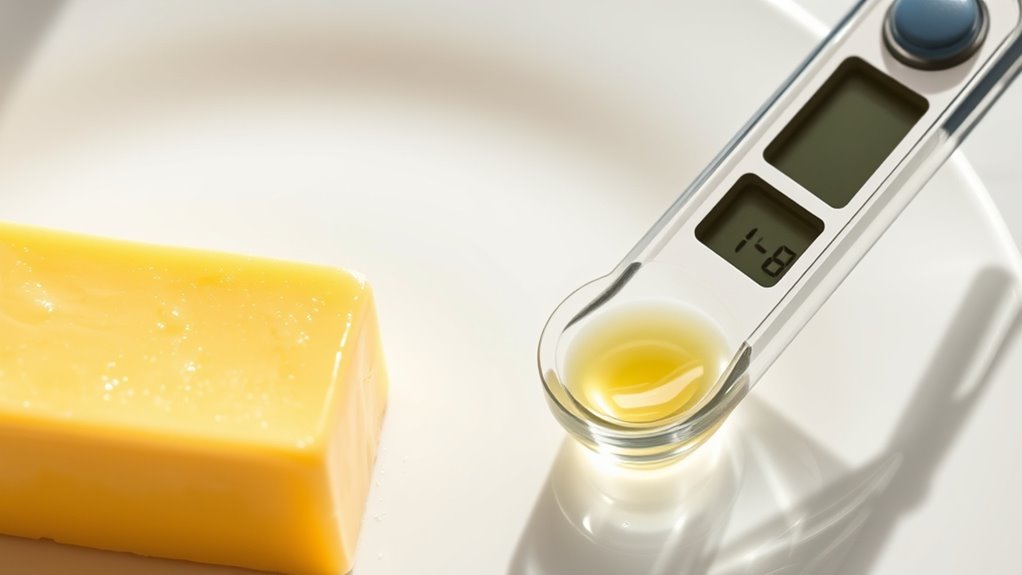
Measuring the pH of butter accurately is essential for quality control and ensuring proper flavor and texture. To do this, start with a clean, calibrated pH meter designed for semi-solid samples. Gently melt a small portion of butter to ensure a uniform sample, but avoid overheating, which can alter pH levels. Dip the electrode into the melted butter, making sure it’s fully submerged without air bubbles. Wait for the reading to stabilize before recording. Accurate pH measurement helps monitor dairy fermentation processes and pH balancing efforts, which influence butter’s acidity and shelf life. Regular testing ensures consistency, detects spoilage early, and maintains ideal quality for your products. Proper technique is key to obtaining precise, reliable results. Additionally, understanding the effect of pH on flavor can guide adjustments to improve your butter’s taste profile.
Factors That Affect Butter’S Ph Level
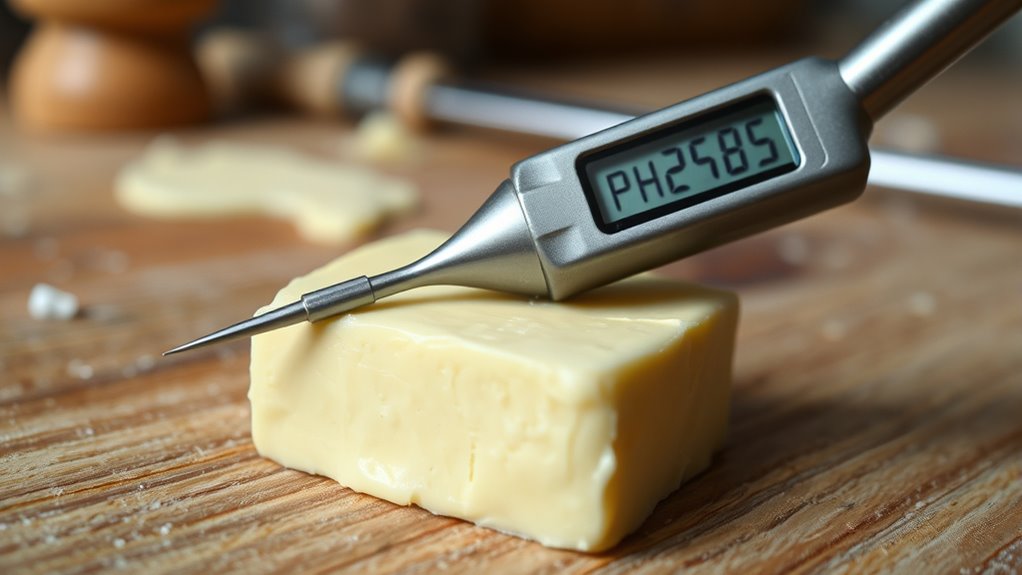
Several factors can influence the pH level of butter, affecting its acidity and overall stability. Dairy fermentation plays a key role, as the fermentation process produces lactic acid, which lowers pH levels. Proper acidity control during production is essential to prevent spoilage and maintain quality. Additionally, storage conditions impact pH; exposure to air or bacteria can alter acidity over time. Here are the main factors:
- Dairy fermentation: Controls the balance of acids formed during milk conversion.
- Storage environment: Temperature and exposure influence bacterial activity and pH stability.
- Processing techniques: Pasteurization and handling affect microbial content and acidity levels.
- Maintaining a controlled storage environment is vital for preserving the desired pH and preventing spoilage.
The Relationship Between Ph and Butter Quality
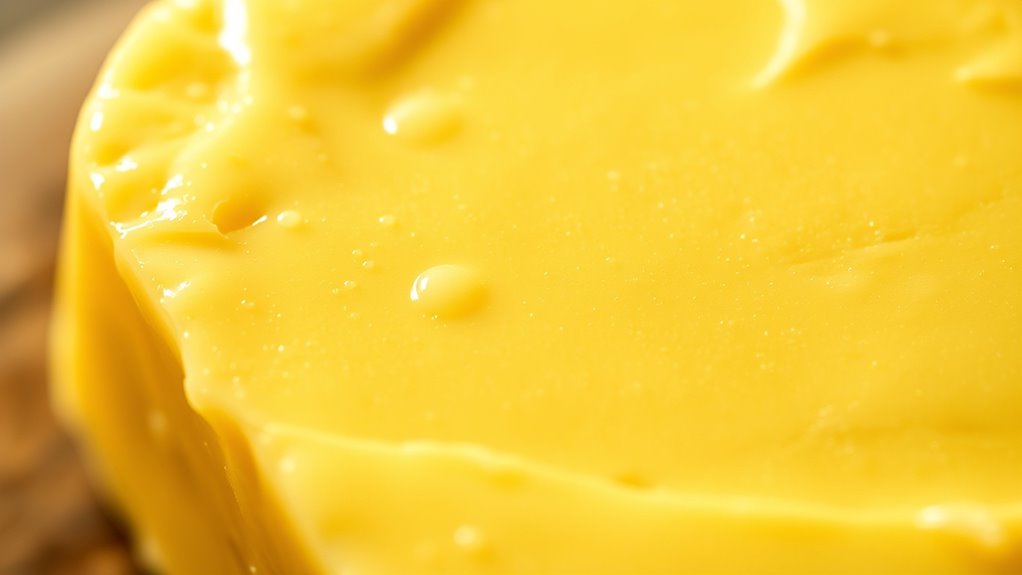
The pH level of butter directly influences its quality, affecting factors like flavor, texture, and shelf life. During dairy fermentation, natural acids lower the pH, which can enhance butter’s flavor profile but also impact stability. Proper pH adjustment is essential; if the pH is too high, butter may develop off-flavors or become more prone to spoilage. Conversely, a well-controlled pH ensures consistent texture and prolongs shelf life. Dairy fermentation processes play a key role in establishing the ideal pH, shaping butter’s overall quality. Understanding this relationship helps you maintain product consistency and quality. By managing pH levels through fermentation and adjustment, you can optimize butter’s flavor, stability, and longevity beyond basic baking needs.
Practical Tips for Using Ph Knowledge in Baking

Understanding pH levels can profoundly improve your baking results, especially when working with ingredients like butter and dairy products. To maximize flavor development, pay attention to butter storage, as improper storage can alter pH and affect taste. Managing pH helps in controlling acidity, which influences dough fermentation and texture. Here are practical tips:
- Store butter in airtight containers to prevent pH shifts caused by exposure to air or contaminants.
- Adjust recipes by adding acidic or alkaline ingredients to achieve the desired pH balance.
- Test pH levels regularly using simple kits to monitor and maintain ideal conditions for flavor and texture.
Frequently Asked Questions
Can Altering Butter’S Ph Improve Its Nutritional Value?
Altering butter’s pH can influence its nutritional value, especially through dairy fermentation processes that can increase beneficial probiotics. While adjusting pH might enhance flavor and extend shelf life, it doesn’t necessarily boost nutrition directly. However, fermentation can improve digestibility and add nutrients. So, by controlling pH during fermentation, you can create a butter with better flavor and potentially more health benefits, making it a smarter choice for your diet.
How Does Ph Affect Butter’S Interaction With Other Ingredients?
Ever wonder how your butter’s pH sneaks into your recipes? It dramatically impacts emulsification, helping fats and water mix smoothly, and shapes the flavor profile—making it richer or tangier. When pH levels shift, your ingredients might refuse to cooperate or turn into a flavor circus. So, controlling butter’s pH isn’t just chemistry; it’s your secret weapon for perfectly blending ingredients and crafting irresistible tastes.
Is There a Safe Ph Range for Storing Flavored Butters?
You should aim for a pH range of about 4.6 to 6.0 for storing flavored butters. Maintaining this pH stability helps prevent bacterial growth and guarantees storage safety. If the pH drops too low or rises too high, it can compromise your butter’s freshness and safety. Always monitor and adjust your flavored butter’s pH to keep it within this safe range, ensuring it stays fresh longer.
Does Ph Impact the Melting Point of Butter?
Think of pH as the secret handshake that influences butter’s melting point. When you alter the pH, it can change the texture and how quickly butter melts, much like a tune changing with the mood. A lower pH might lower the melting point, making it softer, while a higher pH can make it more stable. This impacts not just texture but shelf life, ensuring your butter stays fresh longer.
How Does Ph Influence Butter’S Susceptibility to Rancidity?
You might wonder how pH influences butter’s susceptibility to rancidity. A lower pH (more acidity) can slow down microbial growth, aiding in butter preservation. Proper acidity control helps prevent oxidation that leads to rancidity, keeping your butter fresh longer. By maintaining ideal pH levels, you reduce the risk of spoilage and extend shelf life, ensuring your butter stays flavorful and safe to consume.
Conclusion
Understanding the pH of butter isn’t just for bakers—it’s a hidden key to flavor, texture, and freshness. As you experiment in the kitchen, remember that small pH shifts can unexpectedly transform your results. So next time you spread butter on toast or bake a cake, consider the unseen acidity behind its creaminess. Sometimes, the tiniest details make all the difference—you might just discover your new favorite recipe by paying attention to its pH.
